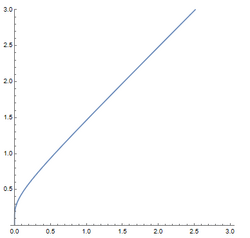Bernoulli umbra
In Umbral calculus, the Bernoulli umbra [math]\displaystyle{ B_- }[/math] is an umbra, a formal symbol, defined by the relation [math]\displaystyle{ \operatorname{eval}B_-^n=B^-_n }[/math], where [math]\displaystyle{ \operatorname{eval} }[/math] is the index-lowering operator,[1] also known as evaluation operator [2] and [math]\displaystyle{ B^-_n }[/math] are Bernoulli numbers, called moments of the umbra.[3] A similar umbra, defined as [math]\displaystyle{ \operatorname{eval}B_+^n=B^+_n }[/math], where [math]\displaystyle{ B^+_1=1/2 }[/math] is also often used and sometimes called Bernoulli umbra as well. They are related by equality [math]\displaystyle{ B_+=B_-+1 }[/math]. Along with the Euler umbra, Bernoulli umbra is one of the most important umbras.
In Levi-Civita field, Bernoulli umbras can be represented by elements with power series [math]\displaystyle{ B_-= \varepsilon^{-1} -\frac{1}{2}-\frac{\varepsilon }{24}+\frac{3 \varepsilon ^3}{640}-\frac{1525 \varepsilon ^5}{580608}+\dotsb }[/math] and [math]\displaystyle{ B_+= \varepsilon^{-1} +\frac{1}{2}-\frac{\varepsilon }{24}+\frac{3 \varepsilon ^3}{640}-\frac{1525 \varepsilon ^5}{580608}+\dotsb }[/math], with lowering index operator corresponding to taking the coefficient of [math]\displaystyle{ 1=\varepsilon^0 }[/math] of the power series. The numerators of the terms are given in OEIS A118050[4] and the denominators are in OEIS A118051.[5] Since the coefficients of [math]\displaystyle{ \varepsilon^{-1} }[/math] are non-zero, the both are infinitely large numbers, [math]\displaystyle{ B_- }[/math] being infinitely close (but not equal, a bit smaller) to [math]\displaystyle{ \varepsilon^{-1}-1/2 }[/math] and [math]\displaystyle{ B_+ }[/math] being infinitely close (a bit smaller) to [math]\displaystyle{ \varepsilon^{-1}+1/2 }[/math].
In Hardy fields (which are generalizations of Levi-Civita field) umbra [math]\displaystyle{ B_+ }[/math] corresponds to the germ at infinity of the function [math]\displaystyle{ \psi^{-1}(\ln x) }[/math] while [math]\displaystyle{ B_- }[/math] corresponds to the germ at infinity of [math]\displaystyle{ \psi^{-1}(\ln x)-1 }[/math], where [math]\displaystyle{ \psi^{-1}(x) }[/math] is inverse digamma function.
Exponentiation
Since Bernoulli polynomials is a generalization of Bernoulli numbers, exponentiation of Bernoulli umbra can be expressed via Bernoulli polynomials:
- [math]\displaystyle{ \operatorname{eval} (B_-+a)^n=B_n(a), }[/math]
where [math]\displaystyle{ a }[/math] is a real or complex number. This can be further generalized using Hurwitz Zeta function:
- [math]\displaystyle{ \operatorname{eval} (B_-+a)^p=-p\zeta(1-p,a). }[/math]
From the Riemann functional equation for Zeta function it follows that
- [math]\displaystyle{ \operatorname{eval}\,B_+^{-p}=\operatorname{eval}\frac{B_+^{p+1} 2^p\pi^{p+1}}{\sin(\pi p/2)\Gamma(p)(p+1)} }[/math]
Derivative rule
Since [math]\displaystyle{ B^+_1=1/2 }[/math] and [math]\displaystyle{ B^-_1=-1/2 }[/math] are the only two members of the sequences [math]\displaystyle{ B^+_n }[/math] and [math]\displaystyle{ B^-_n }[/math] that differ, the following rule follows for any analytic function [math]\displaystyle{ f(x) }[/math]:
- [math]\displaystyle{ f'(x)=\operatorname{eval}(f(B_++x)-f(B_-+x))=\operatorname{eval} \Delta f(B_-+x) }[/math]
Elementary functions of Bernoulli umbra
As a general rule, the following formula holds for any analytic function [math]\displaystyle{ f(x) }[/math]:
- [math]\displaystyle{ \operatorname{eval}f(B_-+x)=\frac{D}{e^D-1} f(x). }[/math]
This allows to derive expressions for elementary functions of Bernoulli umbra.
- [math]\displaystyle{ \operatorname{eval} \cos (z B_-)=\operatorname{eval} \cos (z B_+)=\frac z2 \cot \left(\frac z2\right) }[/math]
- [math]\displaystyle{ \operatorname{eval} \cosh (z B_-)=\operatorname{eval} \cosh (z B_+)=\frac z2 \coth \left(\frac z2\right) }[/math]
- [math]\displaystyle{ \operatorname{eval} e^{z B_-}=\frac{z}{e^{z}-1} }[/math]
- [math]\displaystyle{ \operatorname{eval}\ln ( B_-+z)=\psi(z) }[/math]
Particularly,
- [math]\displaystyle{ \operatorname{eval}\ln B_+=-\gamma }[/math] [6]
- [math]\displaystyle{ \operatorname{eval}\frac1{\pi }\ln \left(\frac{ B _+-\frac{z}{\pi }}{ B _-+\frac{z}{\pi }}\right)=\cot z }[/math]
- [math]\displaystyle{ \operatorname{eval} \frac1\pi\ln \left(\frac{B _-+1/2 +\frac{z}{\pi }}{B _-+1/2 -\frac{z}{\pi }}\right)=\tan z }[/math]
- [math]\displaystyle{ \operatorname{eval}\cos (a B_-+x) = \frac{a}{2} \csc \left(\frac{a}{2}\right) \cos \left(\frac{a}{2}- x\right) }[/math]
- [math]\displaystyle{ \operatorname{eval}\sin (a B_-+x) = \frac{a}{2} \cot \left(\frac{a}{2}\right) \sin x -\frac{a}{2} \cos x }[/math]
Particularly,
- [math]\displaystyle{ \operatorname{eval}\sin B_-=-1/2 }[/math],
- [math]\displaystyle{ \operatorname{eval}\sin B_+=1/2 }[/math],
Relations between exponential and logarithmic functions
Bernoulli umbra allows to establish relations between exponential, trigonometric and hyperbolic functions on one side and logarithms, inverse trigonometric and inverse hyperbolic functions on the other side in closed form:
- [math]\displaystyle{ \operatorname{eval}\left(\cosh \left(2 x B _\pm\right)-1\right)=\operatorname{eval}\frac{x}{\pi} \operatorname{artanh}\left(\frac{x}{\pi B _\pm}\right)=\operatorname{eval}\frac{x}{\pi} \operatorname{arcoth}\left(\frac{\pi B _\pm}{x}\right)=x \coth (x)-1 }[/math]
- [math]\displaystyle{ \operatorname{eval}\frac{z}{2\pi }\ln \left(\frac{ B _+-\frac{z}{2\pi }}{ B _-+\frac{z}{2\pi }}\right)=\operatorname{eval} \cos (z B_-)=\operatorname{eval} \cos (z B_+)=\frac z2 \cot \left(\frac z2\right) }[/math]
References
- ↑ Taylor, Brian D. (1998). "Difference Equations via the Classical Umbral Calculus". Mathematical Essays in honor of Gian-Carlo Rota. pp. 397–411. doi:10.1007/978-1-4612-4108-9_21. ISBN 978-1-4612-8656-1.
- ↑ Di Nardo, E. (February 14, 2022). "A new approach to Sheppard's corrections". arXiv:1004.4989 [math.ST].
- ↑ "The classical umbral calculus: Sheffer sequences". Lecture Notes of Seminario Interdisciplinare di Matematica 8: 101–130. 2009. http://math.fau.edu/Niederhausen/HTML/Papers/The%20classical%20umbral%20calculus%20dinardo_09.pdf.
- ↑ Sloane, N. J. A., ed. "Sequence A118050". OEIS Foundation. https://oeis.org/A118050.
- ↑ Sloane, N. J. A., ed. "Sequence A118051". OEIS Foundation. https://oeis.org/A118051.
- ↑ Yu, Yiping (2010). "Bernoulli Operator and Riemann's Zeta Function". arXiv:1011.3352 [math.NT].
This article needs additional or more specific categories. (February 2022) |
 |


